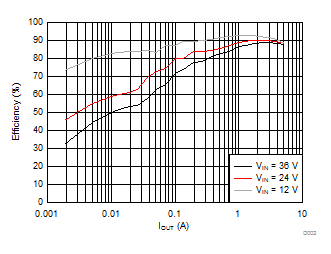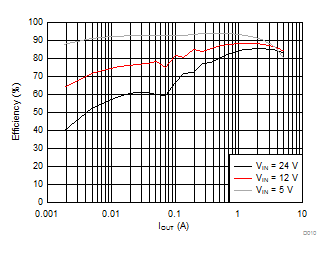SNVSAA6B February 2015 – December 2024 LMR14050
PRODUCTION DATA
- 1
- 1 Features
- 2 Applications
- 3 Description
- 4 Pin Configuration and Functions
- 5 Specifications
-
6 Detailed Description
- 6.1 Overview
- 6.2 Functional Block Diagram
- 6.3
Feature Description
- 6.3.1 Fixed Frequency Peak Current Mode Control
- 6.3.2 Slope Compensation
- 6.3.3 Sleep Mode
- 6.3.4 Low Dropout Operation and Bootstrap Voltage (BOOT)
- 6.3.5 Adjustable Output Voltage
- 6.3.6 Enable and Adjustable Undervoltage Lockout
- 6.3.7 External Soft Start
- 6.3.8 Switching Frequency and Synchronization (RT/SYNC)
- 6.3.9 Overcurrent and Short-Circuit Protection
- 6.3.10 Overvoltage Protection
- 6.3.11 Thermal Shutdown
- 6.4 Device Functional Modes
- 7 Application and Implementation
- 8 Device and Documentation Support
- 9 Revision History
- 10Mechanical, Packaging, and Orderable Information
Package Options
Mechanical Data (Package|Pins)
- DDA|8
Thermal pad, mechanical data (Package|Pins)
- DDA|8
Orderable Information
5.7 Typical Characteristics
Unless otherwise specified the following conditions apply: VIN = 12 V, fSW = 300 kHz, L = 6.5 µH, COUT = 47 µF × 4, TA = 25°C

| VOUT = 5 V | fSW = 500 kHz |

| VOUT = 3.3 V | fSW = 1 MHz |

| VOUT = 5 V | fSW = 500 kHz |

| VOUT = 5 V | fSW = 500 kHz |

| VOUT = 5 V | fSW = 2.2 MHz |
 Figure 5-11 Shut-down Current and Quiescent Current
Figure 5-11 Shut-down Current and Quiescent Current
| VOUT = 5 V | fSW = 1 MHz |

| VOUT = 3.3 V | fSW = 2.2 MHz |

| VOUT = 5 V | fSW = 500 kHz |

| VOUT = 5V | fSW = 1 MHz |

| VOUT = 3.3 V | fSW = 2.2 MHz |

| IOUT = 0 A |